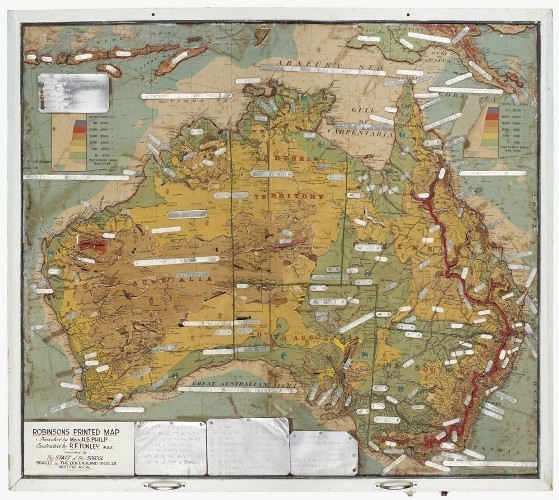
Frank Tunley's braille map of Australia. Source: State Library of Queensland, Accession 29279/29.
Readers of the John Oxley Library blog may remember a previous post regarding photographs of Frank Tunley and the wonderful dolls' houses, models, maps and educational aids which he created for the children at the Brisbane School for the Blind (later known as Narbethong State Special School).
One of the wonderful outcomes of our Magnificent Makers exhibition has been an additional donation from Narbethong of several braille maps, teaching aids, and a braille globe created by Mr Tunley, the "fairy godfather" of blind children. The braille topographic map of Australia, above, was crafted by Mr Tunley in the workshop of his Clayfield home in 1963. It features aluminium name tags, embossed in braille, for the names of places, mountains and other features; twined wire indicating major and minor rivers; and wooden pins showing height above sea level.
Mr Tunley created his first braille map for the children at the school in 1925. At the time it was acknowledged as being a pioneer of its kind in Australia, filling a gap in the educational system for the visually impaired.
The collection also includes two beautifully constructed braille maps of Brisbane which are works of art in their own right.

Braille map of the Brisbane CBD "Between the Three Bridges". Source: State Library of Queensland, Accession 29279/30.
"Brisbane Between the Three Bridges" was created in 1962 and illustrates the main city streets. It also includes relief outlines showing the shapes of the Story Bridge, Victoria Bridge and the William Jolly Bridge, as well as the three bridges side by side at Indooroopilly: Walter Taylor Bridge, and the old and new railway bridges. The braille text reads in part "This relief map shows part of the Brisbane River including streets between the three bridges - Story, Victoria and William Jolly or Grey Street. The river twists and winds through the city like a snake."

This large-scale braille map of the Brisbane suburbs measures 1.2 metres x 800mm. Although constructed by Mr Tunley in 1937 it was not until 1953 that the map was presented to the Brisbane Braille Writing Association. Ferry stops and routes are marked, as well as bridges, with metal strips across the recessed Brisbane River. Twined wire indicate tram and railway lines. The map includes a large red wooden bead to mark the location of Braille House at Annerley, which was officially opened in June 1954 and is still the home of the Queensland Braille Writing Association. Frank Tunley was instrumental in raising funds to purchase the big old Queenslander on Ipswich Road to provide a permanent home for the association and its ever-growing library of braille books.
The achievements of Mr Tunley were incredible. Not only did he provide braille maps for the visually impaired in Queensland, he also sent specially made braille maps to schools for the blind in the other Australian states, as well as overseas to many countries including India, Canada, New Zealand, Syria, Africa and New Guinea - all for no cost. The Post Office carried all braille material free to any country in the Commonwealth and at a small fee to other places world-wide.
Mr Tunley's braille maps, globes and models, as well as beautiful photographs from the Narbethong collection, were on display at the Magnificent Makers: Queensland inventors and their curious creations exhibition in the Phillip Bacon Heritage Gallery on Level 4, from 9 December 2017 to 3 June 2018.
Lynn Meyers - Specialist Librarian, State Library of Queensland
Comments
Your email address will not be published.
We welcome relevant, respectful comments.